| FAQ |
| Members List |
| Social Groups |
| Calendar |
| Search |
| Today's Posts |
|
#1
|
||||
|
||||
|
Hi!
I posted this thread in the Street section but was advised to try here instead. I recently purchased a 1960 Bonneville with number matching 389 (B1 code). The engine seems to be unrestored but runs great. The Bonneville was assembled at the Southgate factory and sold new by Finney Pontiac CA. My question is about the crankcase ventilation. The valve covers doesn't have breather caps, but take fresh air from the aircleaner to the driver side valve cover. It then sucks crankcase fumes via the passenger side valve cover to a connection on the intake manifold. It also have the crankcase ventilation tube at the right rear of the engine. I can't find any information of this system whether in the Shop Manual or from a Web search? Anyone know if this was standard on California models in 1960? 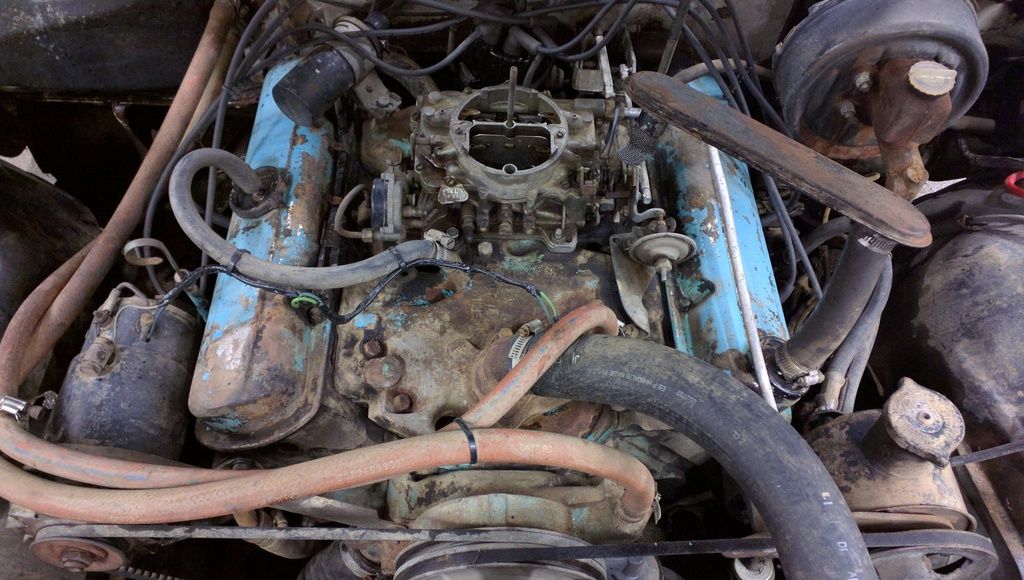 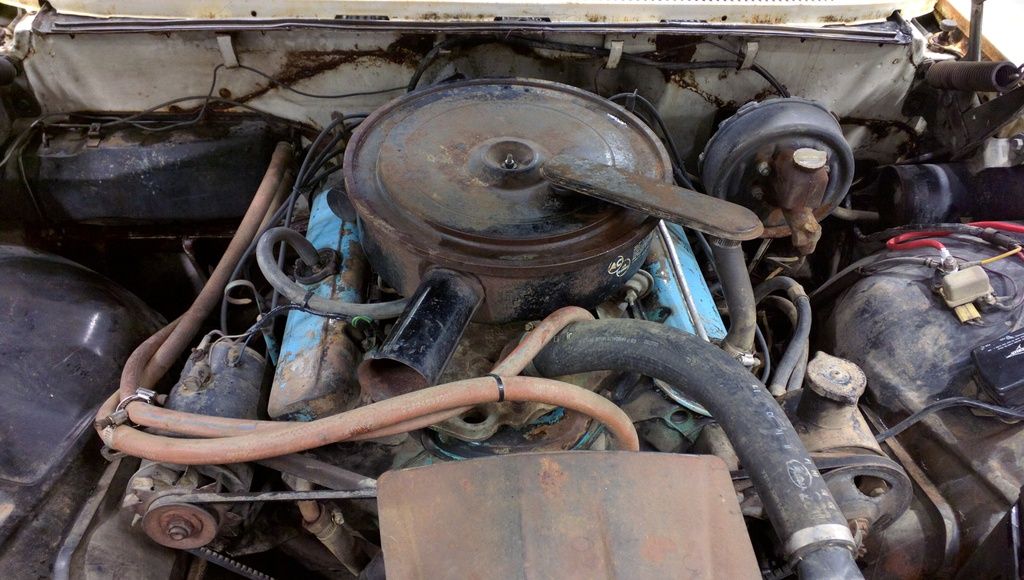  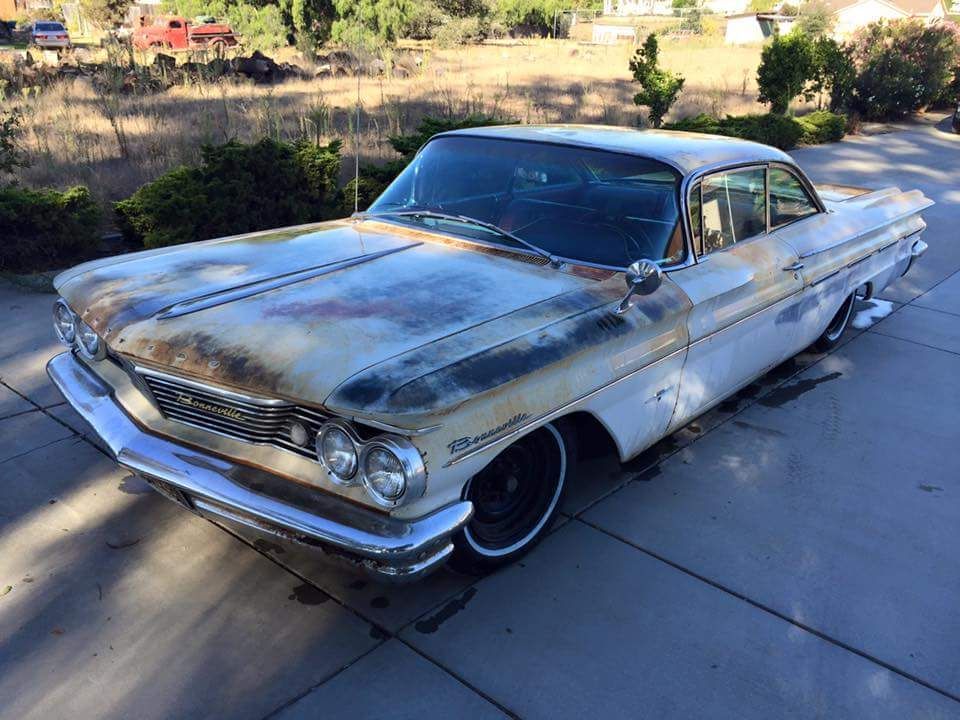
__________________
1960 Bonneville 2dr HT 389/400ci 363hp 1965 Bonneville 2dr HT 455/501ci stroker 600hp+ |
|
#2
|
|||
|
|||
|
I am from California and have never seen such a thing. I was also ASC certified and held a California smog license for many years. There was no smog requirement for a 1960 Pontiac in California or any other state. You should have the crankcase ventilation system that utilizes the road draft system of ventilation, consisting of the valve cover breather caps and the road draft tube that connects to the rear of the valley pan. Just before the tube exits there should be another filter connected to the road draft tube. This filter prevents dirty, dusty air from the road to reverse direction when the engine is off and getting into the engine. On the end of the filter is the small length portion of the tube that is cut at a angle to create a low pressure area to help draft vapors out when the vehicle is in motion. In the picture I provided you can see the tube by the oil filter with the filter attached. This system is what your car should have.
https://encrypted-tbn1.gstatic.com/i...hVMCVvFJGWI7zQ |
|
#3
|
||||
|
||||
|
Interesting setup. As far as I know, the PVC requirement didn't start in California until 1961. I believe it just connected the hole in the valley pan that would otherwise be used for the road draft tube to the base of the carb.
I've heard about that filter that goes on the end of the road draft tube, but curiously I've never seen one on any of the 1961 cars I've owned - maybe they had simply been removed at some point, or maybe they weren't installed on cars in other states. |
|
#4
|
|||
|
|||
|
original 62 cars I have seen had the draft tube.Think the PCV started in 63.Tom
|
|
#5
|
||||
|
||||
|
I was going by information from the 1961 parts catalog - it lists the parts for the PVC system, so I assumed they were for use in California. I suppose it could have been an option.
|
|
#6
|
|||
|
|||
|
Quote:
As far as the Crankcase emission laws goes here it is. In 1961 a crankcase devise was required on California vehicles. Starting in 1962 the rest of the 49states required the PVC setup. There was a time in California when on change of ownership a crankcase devise on pre 1961 to 1955 cars. This law was thrown out just like the NOX rule on older cars of the same vintage cars where the vacuum advance devise was blocked off to reduce NOX emissions... this one caused overheating, poor mileage and saw quite a few engines meet their end prematurely. Fortunately that Ca. legislation was overturned too. |
|
#7
|
|||
|
|||
|
I will tell you my 62 GP did not have a PCV,I pulled the draft tube myself.I have a friend with a all original 62 cat right now that has the draft tube also.Tom
|
|
#8
|
|||
|
|||
|
Tom, is your GP a early production? Apparently according to the 62 manual and service craftsman bulletins there is a early production change over.
|
|
#9
|
|||
|
|||
|
According to Wikipedia;
Positive crankcase ventilation was first factory-installed on a widespread basis by law on all new 1961-model cars first sold in California. The following year, New York required it. By 1964, most new cars sold in the U.S. were so equipped by voluntary industry action so as not to have to make multiple state-specific versions of vehicles. PCV quickly became standard equipment on all vehicles worldwide because of its benefits not only in emissions reduction but also in engine internal cleanliness and oil lifespan. When they say most new cars sold in the U.S. I remember even though VW and Porsche had a crankcase devise on all their cars to the U.S. in 1961, foreign cars were exempt until 1967. Sorry Tom, we were always told and expected to not pass emissions on any 1962 California or 49 state car that didn't have a PCV. according to our Bureau of Automotive Repair Smog manual. Question; did the gold 63 GP 4speed car you had have a PCV? I remember seeing that car at Belmont Shores car show when you had a for sale sign on it. I should have bought it! Last edited by U47; 02-22-2016 at 11:34 PM. |
|
#10
|
||||
|
||||
|
Did California have inspections back then, or some way to confirm the PCV equipment was installed? I'm wondering if some dealers took that 'new fangled gadget' off the cars they sold.

|
|
#11
|
|||
|
|||
|
Quote:
History of Smog Check in California Clean air is everyone's job! 1972 The Bureau of Automotive Repair (BAR) is established within the Department of Consumer Affairs (DCA) with enactment of the Automotive Repair Act (SB 51, Statutes of 1971). The Act provides BAR with licensing and regulating authority over automotive repair dealers. 1972 The CHP operates the Motor Vehicle Inspection Program, which collects emissions data from vehicles during roadside inspections. 1974 The CHP begins issuing "Notices of Correction" to operators of vehicles exceeding pollution standards. 1975-78 DCA/BAR conducts loaded-mode tests in Riverside to gather inspection and repair data. 1977 Amendments to the federal Clean Air Act require states to comply with federal emission standards, prompting California begin the process of creating a statewide vehicle inspection and maintenance program. 1979-84 BAR administers a contractor-run inspection network in the South Coast Air Basin, performing several million inspections on vehicles undergoing a change of ownership. 1982 California becomes the 20th state in the nation to adopt legislation creating a vehicle inspection and maintenance (Smog Check) program (SB 33). 1984 BAR begins administration of the new Smog Check Program. 1990 Responding to amendments to the federal Clean Air Act, the United States Environmental Protection Agency (USEPA) calls for enhanced vehicle emissions testing through a centralized state-run inspection network. California leads a national multi-year effort to create state flexibility in the design of enhanced inspection and maintenance programs. 1995 California adopts its enhanced version of the Smog Check Program, which begins with the cost limit for vehicles requiring emissions repairs changing from a sliding scale amount based on model-year to a $450 minimum for all vehicles (AB 2018, Statutes of 1994; AB 63, Statutes of 1995). 1996 BAR implements a major enhancement to the program, as stations throughout the state transition to an electronic system of communicating Smog Check results to DMV and BAR, utilizing a Vehicle Information Database capable of storing millions of test records. 1997 BAR implements another significant enhancement to the program by having privately-owned licensed Smog Check Test-Only stations as the only entities authorized to inspect and certify vehicles identified as gross polluters (AB 2515, Statutes of 1996). 1997 BAR implements a directed vehicle program that identifies likely high-emitting vehicles, and requires they be repeated and certified at licensed Smog Check Test-Only stations (AB 2515, Statutes of 1997). 1998 BAR implements a major shift in emissions inspection technology to measure a vehicle's NOx emissions, a major smog precursor. Stations in the state's heaviest polluted areas are required to perform a loaded-mode Acceleration Simulation Mode (ASM) test on vehicles using a dynamometer that simulates certain driving conditions. A two-speed idle (TSI) test is still performed in other less-polluted areas of the state. (AB 2515, Statutes of 1997). 1998 Vehicles that are four model-years and newer are exempt from the biennial Smog Check requirement (AB 1492, Statutes of 1997). 2000 BAR implements the Consumer Assistance Program to provide financial assistance to eligible motorists to repair or retire a vehicle that fails a Smog Check (SB 198, Statutes of 1994). 2004 BAR implements the enhanced Smog Check Program in the San Francisco Bay Area (AB 2637, Statutes of 2002). 2005 Vehicles that are six model-years and newer are exempt from the biennial Smog Check requirement. Similarly, vehicles that are four model-years and newer are exempt from the change of ownership Smog Check requirement (SB 1107, Statutes of 2004). 2008 A visible smoke test is added to the Smog Check Program for all model-year vehicles (AB 1870, Statutes of 2006). 2007 After years of extensive study, certification of equipment, and development of test procedures, a low pressure fuel evaporative test (LPFET) is finally added to the Smog Check Program for 1995 and older model-year vehicles (SB 629, Statutes of 1994). 2009 Directed vehicles and gross polluters are authorized to be inspected and certified at Test and Repair stations meeting certain performance standards, in addition to Test-Only stations, under a new Gold Shield Program. 2010 Diesel vehicles model-years 1998 and newer up to 14,000 lbs. GVWR are added to the Smog Check Program (AB 1488, Statutes of 2007). 2013 BAR implements the major recommendation from a 2009 published study by establishing inspection-based performance standards for Smog Check stations. The new STAR Program, which replaces the Gold Shield Program, requires all licensed Smog Check stations to meet these standards to be eligible to inspect directed vehicles (AB 2289, Statutes of 2010). 2014 BAR implements enhanced On-Board Diagnostics Last edited by U47; 02-23-2016 at 12:11 AM. |
|
#12
|
|||
|
|||
|
My GP was not del new to CA.It came into the state early 63 by the ca bulk plate.Im not sure where the blue cat was built,will find out.I have bought new pontiacs in CA ever since 1962 and never remember a inspection in the early to mid 60s.The first I remember was when they started putting smog pumps on the cars.I know for a fact that both these cars and another 62 cat all had the draft tube.I convert the red convert myself.Tom
|
|
#13
|
|||
|
|||
|
As I remember every 63 car I have owned did have a PCV.Tom
|
|
#14
|
|||
|
|||
|
Quote:
|
|
#15
|
|||
|
|||
|
I have a 62 and 63 Catalina. They were both built in South Gate. They both had PCV. systems. The 62 was delivered to Mike Salta.
|
|
#16
|
||||
|
||||
|
Thanks for the replies. Could this be something that was installed at the dealership? Looks like it has been in the car for a while. I will take some more photos and see if I find some part numbers.
__________________
1960 Bonneville 2dr HT 389/400ci 363hp 1965 Bonneville 2dr HT 455/501ci stroker 600hp+ |
|
#17
|
||||
|
||||
|
I took all the parts of the PCV system apart and cleaned them. The only part which has a number is the PCV valve, "AC SPARK PLUG TYPE CV-590C", which seems to be correct for Corvette 1962-1966? All the parts appear to be factory-made. I don't quite understand why the road draft tube wasn't blocked when the system was converted to PCV?
 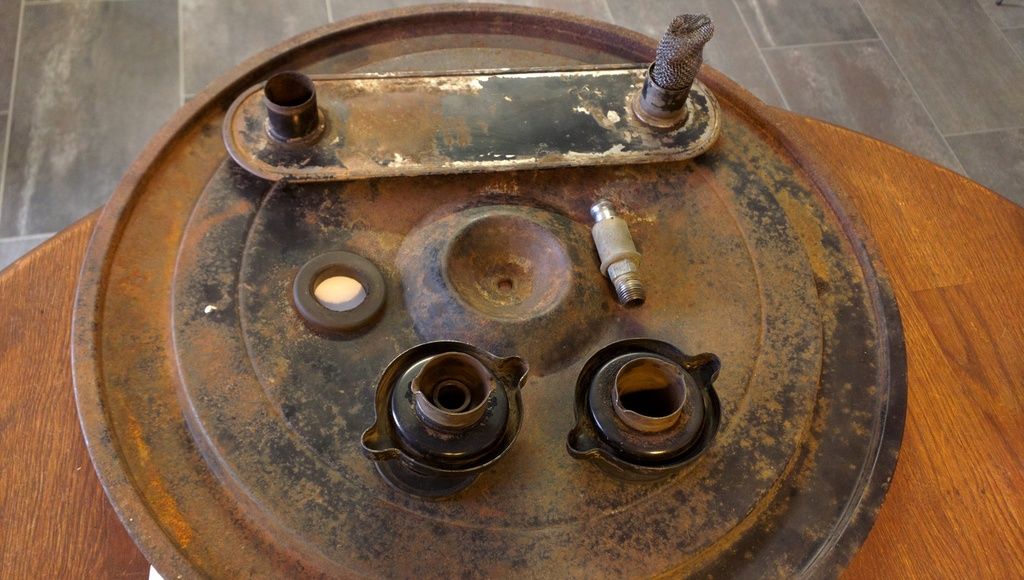
__________________
1960 Bonneville 2dr HT 389/400ci 363hp 1965 Bonneville 2dr HT 455/501ci stroker 600hp+ |
|
#18
|
|||
|
|||
|
The answer is yes. Before the exempt law from testing cars from 1966 to 1975 when into effect, cars were emission tested back to 1966, and that included a visual which included the PCV. We were required to fail any car that didn't pass the visual no matter what the tail pipe emissions were. In fact the visual was and is done first, if the car doesn't pass this visual first the test was and to this day aborted. Some of you might say that if the tailpipe emissions is ok what is the problem? Well there are many devises on a engine emission wise that if taken off will not make a vehicle pass a seven bag ( mode) test even though if the vehicle was warmed up with all or most of them disconnected would pass a CO HC test. It's in the complete drivability cycle test that it would fail.
|
|
#19
|
||||
|
||||
|
On to another subject related to the photos of the engine... The water line routing does not appear to be correct, specifically the waterlines that go across the top of the engine to the heater appear to be incorrect. I think those hoses should not be there and the water nipple on the intake manifold should be connected directly to the nipple on the front cover (routes to water pump inlet). This is the diagram of water circulation in the 1960 Shop Manual. Note the "RECIRCULATION HOSE". That allows circulation of water through the engine during warmup.
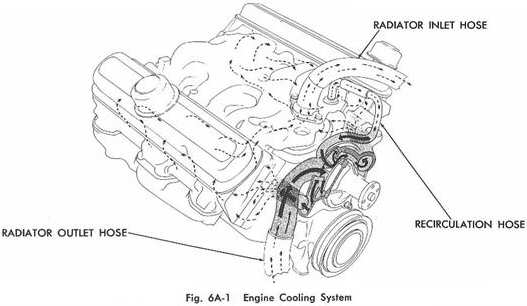 In your configuration, circulaton of water would happen only if the heater valve is open (heat on). I would suspect that in your configuration, engine warmup would be slow if the heater valve is closed. I'm no expert on '60 heater hose routing but I thought heater inlet water was taken from front of head (I see a nipple on passenger's side head attached to a hose in your photo -- but don't know where it goes). |
|
#20
|
|||
|
|||
|
Larry you are correct. If you look at the rt. cylinder head there should be a heater hose connection there. In the picture it looks like a plug hose is used. This is the correct way;
Originally; https://cdn1.mecum.com/auctions/sc05...3-153546_7.jpg later; http://atlantaautoappraiser.com/wp-c...atalina-04.jpg https://s-media-cache-ak0.pinimg.com...0c308558c0.jpg 1962 style; http://image.hotrod.com/f/9062917+w6...x%2bengine.jpg Last edited by U47; 02-26-2016 at 12:54 AM. |
| Reply |
|
|